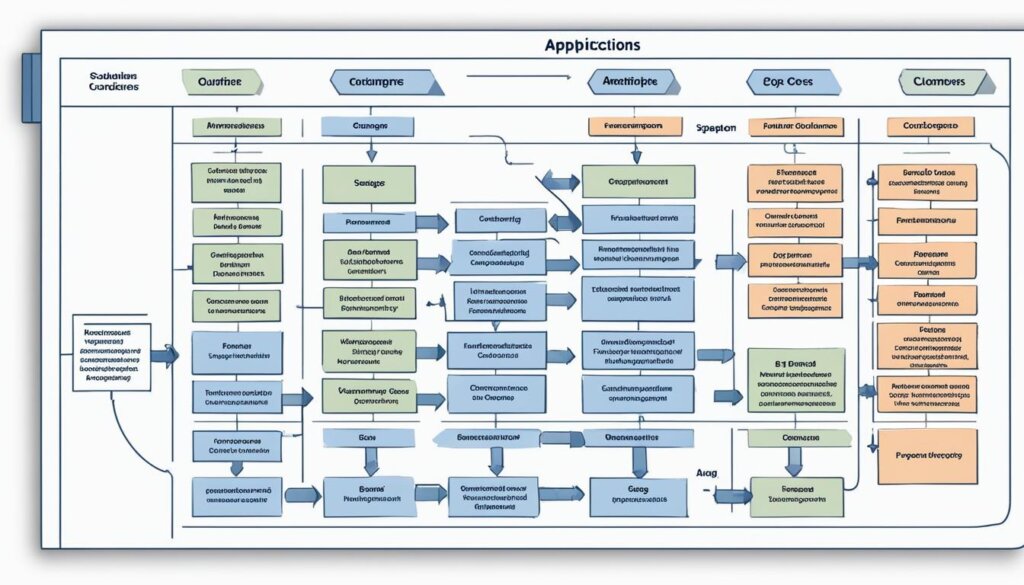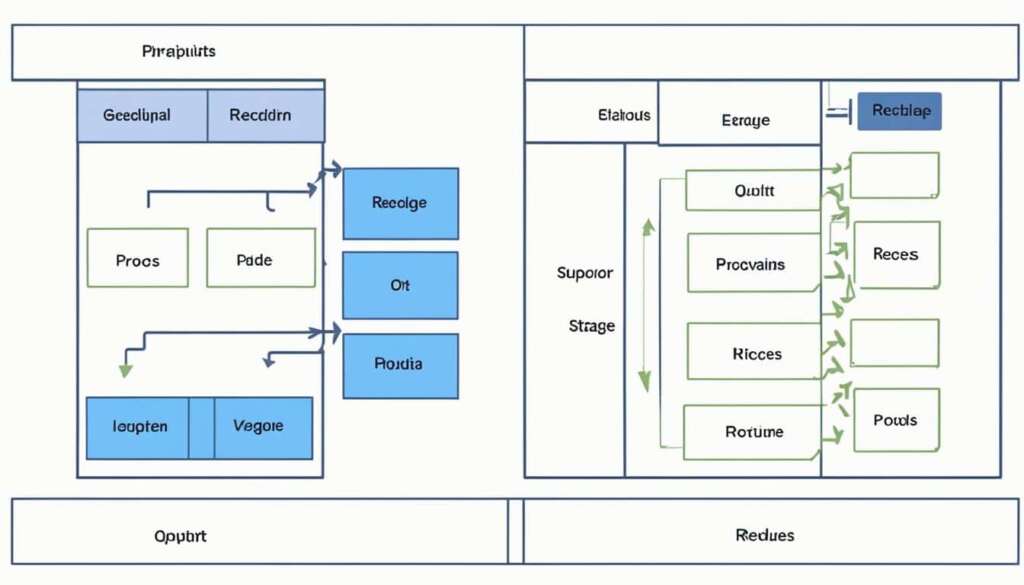Table of Contents
A SIPOC (suppliers, inputs, process, outputs, customers) diagram is a visual tool used to document a business process from beginning to end. It provides a high-level overview and is often referred to as a high-level process map. SIPOC diagrams are particularly useful in continuous improvement efforts and are commonly used in the define phase of the DMAIC (define, measure, analyze, improve, control) methodology of Six Sigma. They help teams to establish a common language and understanding of the process and facilitate discussions around process improvement.
The diagram consists of five columns, labeled S-I-P-O-C, or suppliers, inputs, processes, outputs, and customers. Creating a SIPOC diagram involves choosing a process, defining the process steps, identifying the inputs and outputs, and identifying the suppliers and customers involved. It is a valuable tool for identifying problem areas, conducting process analysis, and ensuring all team members are on the same page.
The benefits of using a SIPOC diagram include increased transparency, an overview of the project for stakeholders, a training tool for new employees, assistance with problem-solving initiatives, the creation of reusable templates, and alignment among team members.
Whether you are a Six Sigma practitioner, a business analyst, or a project manager, understanding SIPOC diagrams can greatly contribute to your continuous improvement efforts and the success of your projects. In the following sections, we will explore how to create a SIPOC diagram, when to use it, and how it differs from process maps.
How to Create a SIPOC Diagram
Creating a SIPOC diagram is a straightforward process that involves several steps. By following this step-by-step approach, you can effectively chart your business process and gain valuable insights. Let’s explore the process in detail:
-
Choose the Business Process: Start by identifying a specific business process that would benefit from being charted in a SIPOC diagram. It could be a process related to production, service delivery, or any other aspect of your business operations.
-
Define the Process: Provide an overview of the chosen business process by breaking it down into four to five high-level steps. Ensure that these steps capture the essence of the process and provide a clear understanding of its flow.
-
Identify the Outputs: Determine the outputs of the process, which are the products or services created through the execution of the process steps. These outputs represent the deliverables that contribute to the overall value of the process.
-
Identify the Customers: Identify the customers or stakeholders who will receive the outputs or directly benefit from the process. These individuals or groups may include internal teams, external customers, or any other relevant parties who rely on the process outcomes.
-
Identify the Inputs: Next, identify the inputs required for the process to function effectively. These inputs encompass the resources, materials, information, or any other elements necessary for the smooth execution of the process.
-
List the Suppliers: Finally, list the suppliers associated with each input. These suppliers provide the necessary resources or components to support the process. By acknowledging the suppliers, you can understand the dependencies and ensure a smooth supply chain.
Once you have completed the SIPOC diagram, it is crucial to share it with relevant stakeholders. This includes team members, managers, and any other individuals involved in the process. By doing so, you ensure that everyone has a clear understanding of the process flow and the interdependencies it entails.
Additionally, it is important to validate the SIPOC diagram before proceeding with the process. This validation helps confirm the accuracy and comprehensiveness of the diagram, ensuring that all the key elements are accurately represented.
By following these step-by-step guidelines, you can create a comprehensive SIPOC diagram that effectively captures your business process and facilitates better understanding among stakeholders.
When to Use a SIPOC Diagram
A SIPOC diagram has a wide range of applications, with continuous improvement efforts being one of the most popular areas of use. This diagram provides a high-level map of a process, making it a valuable tool in identifying problem areas, conducting process analysis, and explaining business operations to various audiences.
One of the key advantages of using a SIPOC diagram is its ability to help teams identify and centralize important information that may be scattered or unclear within a process. By visually mapping out the suppliers, inputs, processes, outputs, and customers involved, team members are prompted to define and consolidate critical details such as supplier contacts, project specifications, and target customers.
SIPOC diagrams are particularly beneficial in ensuring all team members are on the same page and can be applied across a range of industries and organizational settings. Whether it’s streamlining manufacturing operations, optimizing customer service processes, or improving project management workflows, the SIPOC diagram serves as a guiding framework for continuous improvement initiatives.
Benefits of Using a SIPOC Diagram:
- Increased transparency: The SIPOC diagram provides a clear overview of the project, enhancing transparency for stakeholders and team members.
- Training tool: It serves as a training tool for new employees, helping them understand the overall process and their role within it.
- Facilitates problem-solving: The diagram assists with problem-solving initiatives by visually highlighting areas that require improvement.
- Reusable templates: SIPOC diagrams can serve as reusable templates, allowing organizations to apply the same structure and approach to different processes.
- Alignment among team members: By involving stakeholders in the creation and review of SIPOC diagrams, team members can achieve alignment and a shared understanding of the process.
Overall, SIPOC diagrams are a valuable tool for organizations seeking to enhance their business operations through process analysis and continuous improvement efforts.

Difference Between SIPOC and Process Maps
While both SIPOC diagrams and process maps provide insights into business processes, there are differences between the two.
SIPOC diagrams offer a high-level overview of a process, identifying the key suppliers, inputs, processes, outputs, and customers involved. They are often used at the start of a project to ensure everyone understands how the process works and to align the team and relevant stakeholders.
On the other hand, process maps provide more detailed information about each step in the process, including inputs, outputs, activities, decision points, and areas for potential improvements. Process maps are used to analyze the process in-depth and identify waste.
While SIPOC diagrams capture the key components and steps of a process, process maps provide a more granular view with a focus on interdependencies and improvement opportunities. Process maps allow for a deeper understanding of the intricacies of a process, enabling organizations to make targeted improvements and optimize efficiency.
FAQ
What is a SIPOC diagram?
A SIPOC diagram is a visual tool used to document a business process from beginning to end. It provides a high-level overview and is often referred to as a high-level process map.
How can I create a SIPOC diagram?
Creating a SIPOC diagram involves following a step-by-step process. First, choose a business process to chart in the diagram and provide an overview of the process in four to five high-level steps. Then, identify the outputs, customers, inputs, and suppliers associated with the process. Share and validate the diagram with relevant stakeholders before proceeding with the process.
When should I use a SIPOC diagram?
SIPOC diagrams are useful in continuous improvement efforts and can be applied in various industries and organizational settings. They help in identifying problem areas, conducting process analysis, and explaining business operations. They ensure that all team members are on the same page and provide a common understanding of the process.
What is the difference between a SIPOC diagram and a process map?
While both SIPOC diagrams and process maps provide insights into business processes, there are differences between the two. SIPOC diagrams offer a high-level overview, identifying the key components of the process. On the other hand, process maps provide more detailed information about each step in the process, including inputs, outputs, activities, decision points, and improvement opportunities.


